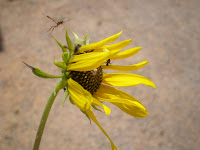Wait! Before we grab that industrial size jug of Ortho and blast those ants out of existence, think for a minute. Why should we blast ants out of existence? Are the ants really hurting anything in our garden? What about that full-spectrum weed killer we’ve been spraying onto our gardens lately? Have we thought about how it kills those weeds and what else it
might kill ? Have we given any thought to
WHY we go to such lengths to keep our gardens so tidy?

It’s resource conflict folks. Yep. Our gardens represent ourselves. If you don’t believe me, ask me to show you a picture of my garden (er…farm). Odds are, I won’t pull out the picture of recently seeded bare rows or a picture of my weeds. I’ll show you my garden in full flower and dressed up in its Sunday best. Our gardens (or farms) are extensions of ourselves. We want them to present the best possible picture of us. They provision us. They nurture us. When our gardens fail, it reflects poorly on our ability to provide. Yes’m. We put a WHOLE lot more than just money into our gardens.
That’s why we go to such lengths to keep our gardens and farms pest free. Company’s like Ortho KNOW this about us. Just
look at the arsenal of synthetic weed & pest killers available to those of us who want to get our gardens in ship-shape, tout-de-suite. There are pre & post- emergent herbicides, systemic weed killers, non-selective (broad-spectrum) weed killer, selective weed killer, and residual herbicides. Wow. Really? Do we ever ask ourselves why there are so many different categories of weed killers? Keep in mind that the above named are just the categories of commercial weed-killers, not the brand names of all of the weed & pest-killers on the market. To gardeners and farmers, potential enemies could include beneficial weeds,ants, caterpillars or anything else that we THINK might harm our gardens. I don’t know what’s happening in your garden right now, but my garden’s (pardon the pun) being eaten alive!
For example, this year I’ve been hit with several different issues. Leaf minors got my peas and whiteflies got everything else. The birds ate the best crop of apricots we’ve had since we bought the place. Chuck and I were able to salvage TWO measly little apricots from the ENTIRE tree. Don’t get me wrong. We want to share with our wildlife, SHARE being the operative word. To

add insult to injury, the only thing that is
doing even remotely well in my beds this year are my tomatoes...that is until they were hit with rust last week and now even my container tomatoes have blossom-end rot.
So if it's us or them, what do we erstwhile caterpillar hugging, bee-loving, highly evolved gardeners, do? We embrace
integrated pest management (ipm). That’s short for trying a whole lot of different things to keep our gardens alive. Because I eventually want to earn organic certification of some kind, for me this means completely organic IPM. For the leaf miners and whiteflies I first tried a weak solution of biodegradable dish soap which didn’t really do the trick. Next I used Neem.
Now Neem is interesting because it’s all over the market as
natural pesticides and health care products. Buyer beware! Like all things in quantity, naturally derived Neem oil can be dangerous too. It’s also not necessarily approved for organic gardening or farming depending on the “synergists” being used in the products formula (for example, pyrethrin is NOT approved). So, if you plan on using
Neem oil, do your research. Eventually, I ended up calling my
local agricultural extension agent and the
organic certification unit to make certain I could use the Neem oil had purchased. Once you use something that is not on the
list of acceptable products, you have to go back and start at square one – so be careful!

Next year I plan on using the following ipm: Biodegradable vegetable soap, Neem Oil, lady bugs and encarsia wasps. I MAY use the Tanglefoot traps I used this year as an absolute last resort. They work, but they also capture beneficial wasps and bees. In addition to this arsenal, I also plan on using bed rotation and cover crops. Next project? Finding the best
native cover crops available to us. Native covers will help me
attract those insects I want, improve my soil, and keep down invasive weeds!












 Dill
Dill




